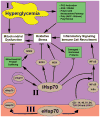Promoting Neuronal Tolerance of Diabetic Stress: Modulating Molecular Chaperones
- PMID: 27133150
- PMCID: PMC4929789
- DOI: 10.1016/bs.irn.2016.03.001
Promoting Neuronal Tolerance of Diabetic Stress: Modulating Molecular Chaperones
Abstract
The etiology of diabetic peripheral neuropathy (DPN) involves an interrelated series of metabolic and vascular insults that ultimately contribute to sensory neuron degeneration. In the quest to pharmacologically manage DPN, small-molecule inhibitors have targeted proteins and pathways regarded as "diabetes specific" as well as others whose activity are altered in numerous disease states. These efforts have not yielded any significant therapies, due in part to the complicating issue that the biochemical contribution of these targets/pathways to the progression of DPN does not occur with temporal and/or biochemical uniformity between individuals. In a complex, chronic neurodegenerative disease such as DPN, it is increasingly appreciated that effective disease management may not necessarily require targeting a pathway or protein considered to contribute to disease progression. Alternatively, it may prove sufficiently beneficial to pharmacologically enhance the activity of endogenous cytoprotective pathways to aid neuronal tolerance to and recovery from glucotoxic stress. In pursuing this paradigm shift, we have shown that modulating the activity and expression of molecular chaperones such as heat shock protein 70 (Hsp70) may provide translational potential for the effective medical management of insensate DPN. Considerable evidence supports that modulating Hsp70 has beneficial effects in improving inflammation, oxidative stress, and glucose sensitivity. Given the emerging potential of modulating Hsp70 to manage DPN, the current review discusses efforts to characterize the cytoprotective effects of this protein and the benefits and limitations that may arise in drug development efforts that exploit its cytoprotective activity.
Keywords: Bioenergetics; Diabetic neuropathy; Heat shock proteins; Hsp70; Inflammation; Molecular chaperones; Novologues.
© 2016 Elsevier Inc. All rights reserved.
Figures



Similar articles
-
Modulating Molecular Chaperones Improves Mitochondrial Bioenergetics and Decreases the Inflammatory Transcriptome in Diabetic Sensory Neurons.ACS Chem Neurosci. 2015 Sep 16;6(9):1637-48. doi: 10.1021/acschemneuro.5b00165. Epub 2015 Jul 22. ACS Chem Neurosci. 2015. PMID: 26161583 Free PMC article.
-
Heat shock protein 70 is necessary to improve mitochondrial bioenergetics and reverse diabetic sensory neuropathy following KU-32 therapy.J Pharmacol Exp Ther. 2014 Feb;348(2):281-92. doi: 10.1124/jpet.113.210435. Epub 2013 Nov 21. J Pharmacol Exp Ther. 2014. PMID: 24263156 Free PMC article.
-
Diabetic peripheral neuropathy: should a chaperone accompany our therapeutic approach?Pharmacol Rev. 2012 Oct;64(4):880-900. doi: 10.1124/pr.111.005314. Epub 2012 Aug 10. Pharmacol Rev. 2012. PMID: 22885705 Free PMC article. Review.
-
Novologue Therapy Requires Heat Shock Protein 70 and Thioredoxin-Interacting Protein to Improve Mitochondrial Bioenergetics and Decrease Mitophagy in Diabetic Sensory Neurons.ACS Chem Neurosci. 2021 Aug 18;12(16):3049-3059. doi: 10.1021/acschemneuro.1c00340. Epub 2021 Aug 3. ACS Chem Neurosci. 2021. PMID: 34340312 Free PMC article.
-
Targeting the Diabetic Chaperome to Improve Peripheral Neuropathy.Curr Diab Rep. 2016 Aug;16(8):71. doi: 10.1007/s11892-016-0769-8. Curr Diab Rep. 2016. PMID: 27318486 Free PMC article. Review.
Cited by
-
Decreased ZO1 expression causes loss of time-dependent tight junction function in the liver of ob/ob mice.Mol Biol Rep. 2022 Dec;49(12):11881-11890. doi: 10.1007/s11033-022-07940-x. Epub 2022 Oct 12. Mol Biol Rep. 2022. PMID: 36224445
-
Ammonium Glycyrrhizinate Prevents Apoptosis and Mitochondrial Dysfunction Induced by High Glucose in SH-SY5Y Cell Line and Counteracts Neuropathic Pain in Streptozotocin-Induced Diabetic Mice.Biomedicines. 2021 May 26;9(6):608. doi: 10.3390/biomedicines9060608. Biomedicines. 2021. PMID: 34073550 Free PMC article.
-
Alfalfa-derived HSP70 administered intranasally improves insulin sensitivity in mice.Cell Stress Chaperones. 2018 Mar;23(2):189-194. doi: 10.1007/s12192-017-0835-4. Epub 2017 Aug 18. Cell Stress Chaperones. 2018. PMID: 28822083 Free PMC article.
-
Muscarinic Receptor Antagonism and TRPM3 Activation as Stimulators of Mitochondrial Function and Axonal Repair in Diabetic Sensorimotor Polyneuropathy.Int J Mol Sci. 2025 Jul 31;26(15):7393. doi: 10.3390/ijms26157393. Int J Mol Sci. 2025. PMID: 40806522 Free PMC article. Review.
-
A muscarinic receptor antagonist reverses multiple indices of diabetic peripheral neuropathy: preclinical and clinical studies using oxybutynin.Acta Neuropathol. 2024 Mar 25;147(1):60. doi: 10.1007/s00401-024-02710-4. Acta Neuropathol. 2024. PMID: 38526612 Clinical Trial.
References
-
- Afolayan AJ, Teng RJ, Eis A, Rana U, Broniowska KA, Corbett JA, et al. Inducible Hsp70 regulates superoxide dismutase-2 and mitochondrial oxidative stress in the endothelial cells from developing lungs. American Journal of Physiology: Lung Cellular and Molecular Physiology. 2014;306:L351–360. - PMC - PubMed
-
- Agou F, Ye F, Goffinont S, Courtois G, Yamaoka S, Israel A, et al. Nemo trimerizes through its coiled-coil C-terminal domain. Journal of Biological Chemistry. 2002;277:17464–17475. - PubMed
-
- Asea A, Kraeft SK, Kurt-Jones EA, Stevenson MA, Chen LB, Finberg RW, et al. Hsp70 stimulates cytokine production through a CD14-dependent pathway, demonstrating its dual role as a chaperone and cytokine. Nature Medicine. 2000;6:435–442. - PubMed
-
- Asea A, Rehli M, Kabingu E, Boch JA, Bare O, Auron PE, et al. Novel signal transduction pathway utilized by extracellular Hsp70: Role of toll-like receptor (TLR) 2 and TLR4. Jornal of Biological Chemistry. 2002;277:15028–15034. - PubMed
Publication types
MeSH terms
Substances
Grants and funding
LinkOut - more resources
Full Text Sources
Other Literature Sources
Medical

